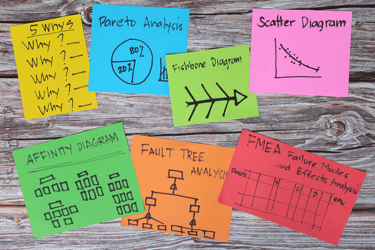The Packaging Industry's Sustainability Challenge: Why ERP Systems Are Essential for Success A straightforward guide to navigating sustainability regulations across folding carton, flexible...
Navigating EUDR Regulation: A Guide for the Packaging Industry
Understanding EUDR regulation is crucial for packaging businesses to stay compliant and competitive in an evolving market.
Contents
Understanding EUDR: What It Stands For And Its Origins
EUDR stands for the European Union Deforestation Regulation, and was introduced by the European Commission (EC). The regulation aims to ensure that products sold in the EU do not contribute to deforestation and forest degradation globally.
This legislation was established principally to combat deforestation and forest degradation caused by the expansion of agricultural land, including for the production of commodities such as soy, beef, palm oil, wood, cocoa, and coffee.
Packaging materials fall under the EU Deforestation Regulation (EUDR) if sold as standalone products, but are generally exempt if used to support, protect, or carry other products.
The origins of EUDR can be traced back to the EU's commitment to environmental sustainability and climate change mitigation. It evolved from earlier initiatives like the EU Timber Regulation (EUTR) and the Forest Law Enforcement, Governance and Trade (FLEGT) Action Plan, reflecting an intensified focus on environmental protection and sustainable development.
The Scope of EUDR: What It Covers and Who Enforces It
EUDR covers a wide range of products and commodities that are associated with deforestation. This includes, but is not limited to, soy, beef, palm oil, wood, cocoa, coffee, and derived products such as chocolate, furniture, and certain packaging materials. The regulation requires businesses to ensure that these products are sourced responsibly and do not contribute to deforestation.
The enforcement of EUDR is carried out by national authorities within the EU member states. These authorities are responsible for monitoring compliance, conducting checks, and imposing penalties on businesses that fail to adhere to the regulation. The European Commission also plays a role in coordinating efforts and ensuring uniform implementation across the EU.
EUDR Timeline: Key Milestones and Dates
June 2020
The European Commission (EC) kicked off the process with a roadmap inviting public feedback on its initiative to address global deforestation. This marked the start of a broader strategy to reduce greenhouse gas emissions and preserve biodiversity.
June 2023
The regulation officially entered into force. Compliance timelines were set based on business size:
- Large companies: Must comply by December 2024
- Small and medium enterprises (SMEs): Must comply by June 2025
|
Company Size |
Employees |
Annual Turnover |
Total Assets |
|
Large Enterprise |
More than 250 |
Over €50 million |
Over €43 million |
|
Medium Enterprise |
50 – 249 |
≤ €50 million |
≤ €43 million |
|
Small Enterprise |
10 – 49 |
≤ €10 million |
≤ €10 million |
|
Micro Enterprise |
Fewer than 10 |
≤ €2 million |
≤ €2 million |
https://ec.europa.eu/eurostat/statistics-explained/index.php?title=Main_Page
October 2024
Recognizing challenges in industry readiness, the EC proposed a 12-month extension for compliance:
-
Large businesses: New compliance deadline of December 30, 2025
-
SMEs: New compliance deadline of June 30, 2026
Additional guidance was also released to clarify traceability rules, penalties, and key terms like "forest degradation."
Impact on Packaging: How EUDR Affects Folding Carton, Flexible Packaging, Corrugated Packaging, and Tag & Label Companies
For packaging companies, the EUDR presents both challenges and opportunities. The regulation requires these businesses to scrutinize their supply chains to ensure that the materials they use do not contribute to deforestation. This means greater due diligence and potentially higher costs associated with sourcing certified and compliant materials.
However, compliance with EUDR can also be a competitive advantage. Packaging companies that can demonstrate their commitment to sustainability and responsible sourcing can enhance their brand reputation and appeal to environmentally conscious consumers and clients. This can lead to increased market share and customer loyalty in a market that increasingly values sustainability.
Compliance Strategies: Steps for Packaging Companies to Align with EUDR
To align with EUDR, packaging companies should start by conducting a thorough assessment of their supply chains. This includes identifying and mapping out all sources of raw materials and ensuring they are compliant with EUDR standards. Engaging with suppliers and requiring them to provide evidence of sustainable practices is crucial.
Companies should also invest in certification schemes and traceability systems that verify the sustainability of their materials. Implementing internal policies and training programs to educate employees about EUDR requirements and the importance of sustainable sourcing can further ensure compliance.
Utilizing technology solutions, such as ERP systems specifically designed for the packaging industry, can aid in managing and tracking compliance efforts efficiently.
Future Outlook: The Evolving Landscape of EUDR and the Packaging Industry
The landscape of EUDR and its impact on the packaging industry is expected to evolve. As environmental concerns continue to rise, regulations are likely to become more stringent, and the scope of covered products may expand. Packaging companies must stay abreast of these changes and continuously adapt their practices to remain compliant.
Embracing sustainability not only ensures compliance but also positions companies as leaders in the industry. By leveraging innovative solutions and technologies, such as MES Applications, packaging businesses can streamline their operations, reduce risks, and capitalize on the growing demand for sustainable products.
The future of packaging lies in balancing regulatory compliance with proactive sustainability initiatives, ensuring long-term success and resilience in a dynamic market.




